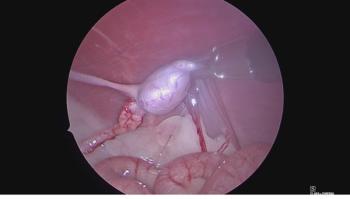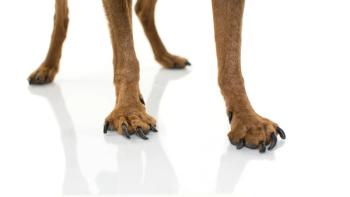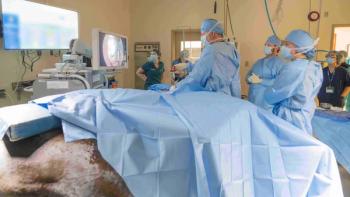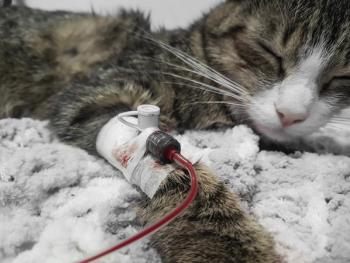
Photo gallery: Novel veterinary surgical technique helps lengthen dog's leg
In this photo gallery, veterinary surgeon Scott Palmer demonstrates how he straightened and lengthened a disfigured leg of a Great Dane puppy by using a novel surgical technique.
To save a dog's leg, a veterinary orthopedic surgeon recently tried something radical. With the owner's approval, he severed the tibia and used a novel device to facilitate bone growth thereby lengthening and straightening a Great Dane puppy's leg.
In fact, Ross H. Palmer, DVM, MS, Dipl. ACVS, associate professor of orthopedic surgery at Colorado State University's Veterinary Teaching Hospital, pursued a technique first tested more than 20 years ago.
This situation required the straightening and lengthening of a tibia on a Great Dane puppy named Cooper. According to Palmer, the dog broke its tibia shortly after it was born. To correct the disparity in leg length, Palmer inserted a metal jack that was screwed to each end of the bone. Each day, the pet owner lengthened the device by about 2 millimeters to facilitate bone growth.
Over several months, Cooper's leg slowly grew 76 mm, about 3 inches. Thirty-six mm were added as a result of the corrective surgery and 40 mm were added because of the pet owner's daily adjustments.
(Images courtesy of Dr. Ross Palmer.)
This pre-operative lateral radiograph shows marked recurvatum tibial deformity and distal tibial physeal closure. This radiograph was used for corrective osteotomy planning in the sagittal plane. A cranio-caudal radiograph was used for corrective osteotomy planning in the frontal plane.
This intra-operative cranio-caudal fluoroscopic image shows marked distal tibial varus deformity. The diaphyseal k-wires were placed to guide the orientation of the osteotomies and the metaphyseal k-wires to guide placement of the proximal- and distal-most fixator pins parallel to their adjacent joints.
This intra-operative cranio-caudal fluoroscopic image shows replacement of metaphyseal k-wires with pre-drilled fixator pins (DurafaceTM, IMEX Veterinary, Inc.)
This intra-operative cranio-caudal fluoroscopic image shows correction of the marked distal tibial varus deformity. Pure opening wedge osteotomy was not performed because of soft-tissue restrictions that would not permit the multi-planar correction. There were also concerns regarding the feasibility of distraction osteogenesis from a wide wedge defect. Pure closing wedge ostectomy was not performed due to the limits of the size of the human distraction device. A combination closing wedge (caudo-laterally) and opening wedge (cranio-medially) was performed. Note that proximal and distal segments are still free to rotate in the sagittal plane around the single fixator pins.
This intra-operative cranio-caudal fluoroscopic image shows addition fixator pins to each bone segment to restrict sagittal plane rotation. Note that the human distraction external fixation device, in its compressed form, barely fits the tibia.
This intra-operative lateral lateral fluoroscopic image shows correction of the recurvatum tibial deformity. The device was placed to the tibia with the recurvatum deformity in place and the central hinge allowed correction in the sagittal plane via the osteotomies.
This post-operative lateral radiograph shows correction of the recurvatum tibial deformity. Note that the human distraction external fixation device, in its compressed form, barely fits the tibia. The device was placed to the deformity tibia and the central hinge allowed correction in the sagittal plane after the osteotomies were performed.
This lateral radiograph on day 7 shows evidence of early callus formation along the caudal margin of the tibia. Note the distraction has been achieved in the frame as evidenced by separation of the two distraction collars and separation of the proximal collar from the proximal pin cluster. The recorded distraction of 12mm matched the measured radiographic tibial lengthening.
The lateral radiograph on day 23 shows callus formation within the osteotomy gap and continued frame distraction totaling 35mm. This was deemed the safe limit of the distraction device and the device was locked in this position until the osteotomy was completely healed.
This lateral radiograph on day 95 shows complete bony union.
See the full story from the November issue of DVM Newsmagazine
Newsletter
From exam room tips to practice management insights, get trusted veterinary news delivered straight to your inbox—subscribe to dvm360.




